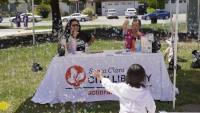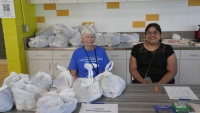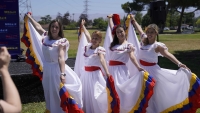Bridging Gaps: The Montague Park Project
Santa Clara City Library
Innovation Synopsis
In 2023, Santa Clara City Library staff saw a need to reach out to a marginalized community in Northern Santa Clara. Residents live in small and overpopulated units far from grocery stores and recreational facilities. The majority are Latinx and Spanish speakers. The average income in this area is much lower than the poverty line for our area. Our intent was to connect this population with community partners to access life-altering resources. We learned that residents do not have a communal space in their immediate area. Thus, all events were hosted at Montague Park, which is only a ten-minute walk from the targeted population.
With funding from the California State Library, we hosted five events that focused on culture, nutrition and STEAM education. These were co-designed by residents through community meetings and conversations. This project introduced residents to a new communal space and created new bridges to the Library, Parks and Recreation, and our community partners.
Challenge/Opportunity
Our staff immediately saw a visible lack of engagement from our city at this location: limited parking, small units, and broken stairways. This geographically isolated area is surrounded by industrial businesses, train tracks, and a large expressway, making it a food desert. The per capita income here is $38,683, which is significantly lower than the median household income for the City of Santa Clara ($165,352). The closest shopping center is a luxurious plaza with expensive stores and restaurants.
In the beginning of the project, library staff was rejected repeatedly, and having conversations seemed nearly impossible. We knew that we needed to change their perception of public workers and build trust within the community. With funding from the Library Services and Technology Act (LSTA) Inspiration Grant from the California State Library, we co-designed events with this community based on their needs and connected them with resources at an accessible location.
Key Elements of Innovation
The key elements of innovation were thinking of new ways we could reach non-library users and non-English speakers. How could we connect with a community who had never seen an effort from the city to improve their lives? How could we get them to love the library if they had never visited it? Community leaders at Montague Elementary were the bridge between the Library and the residents. Another element of innovation was Montague Park as our main location. Hosting events at the park not only brought the library to them, but strengthened their relationship with the City of Santa Clara. We removed barriers of service by implementing resident feedback into our programs. We ensured all communication was available in Spanish. We created relationships with life-enhancing organizations. We asked questions, absorbed their ideas and brought them to life. We had the funding and resources, but they had the power to shape it into whatever they wanted and needed for their community.
Achieved Outcomes
Residents expressed a high demand for STEAM education for children, and the most spoken languages besides English were Spanish and Vietnamese. Additionally, there was a large interested in food assistance and cultural representation within this small community. Thus, we hosted a total of five events that revolved around STEAM education for families, cultural presentations, and a resource fair with free, life-enhancing resources. Our bookmobile was on site with STEAM books, and titles in Spanish and Vietnamese.
Outcomes for this project are not achievements that can be measured with digits. One of the biggest outcomes is our newly found ability to measure success through the value of our conversations with community and truly elevate their voices. The success of this project was reflected in connections, not numbers. The library is now a trailblazer for the rest of the City of Santa Clara—demonstrating how to better serve our communities and prioritize our vulnerable populations.



